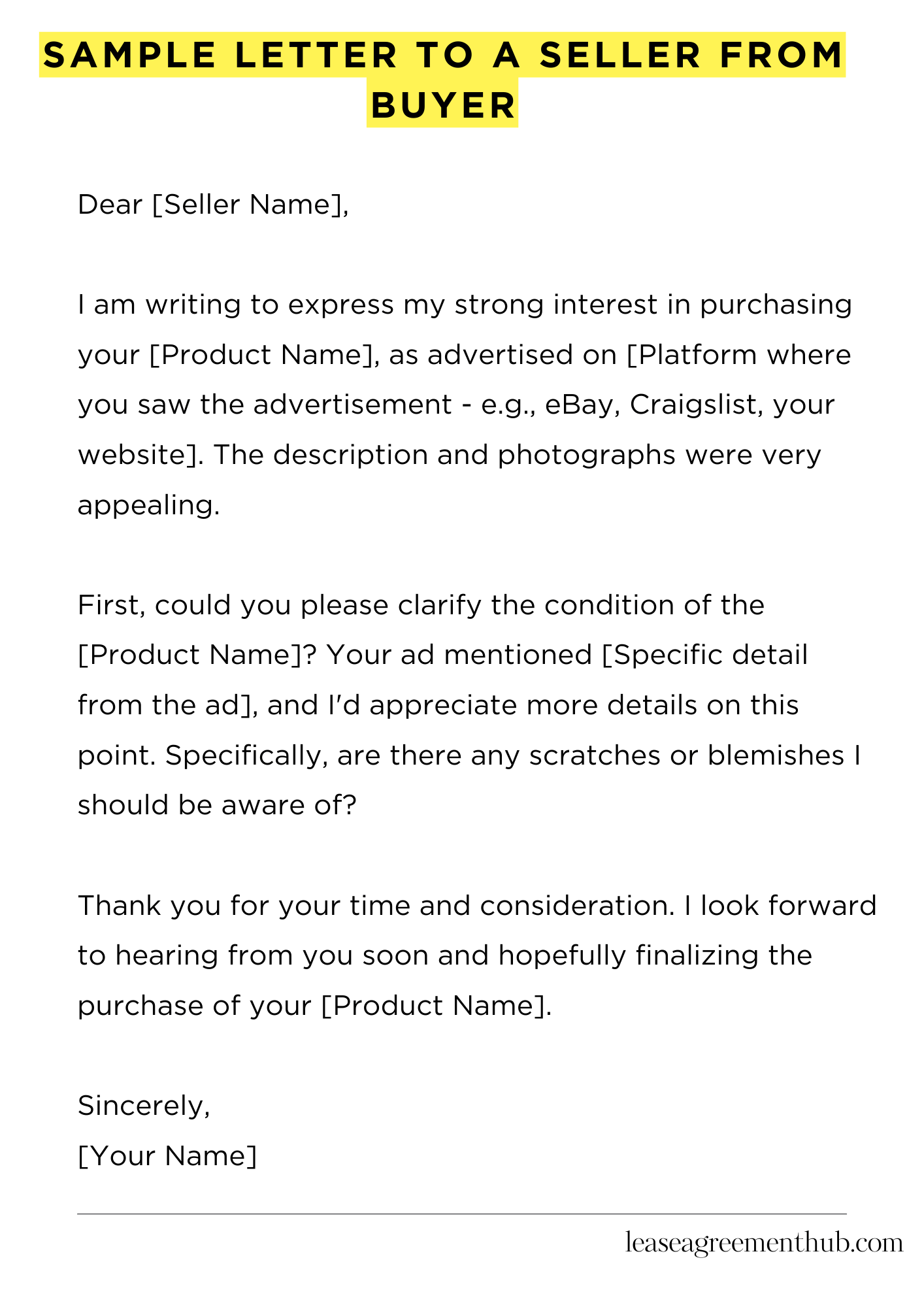A sample letter to a seller from a buyer is a helpful tool. It shows you how to write a letter to a seller. It helps you communicate effectively.
This article gives you examples of these letters. We provide templates. They cover many situations. You’ll find it easy to adapt them.
Use our samples to create your own letter. They’re easy to customize. Write confidently. Get the results you want.
Sample Letter to a Seller from Buyer
[Your Name]
[Your Address]
[Your Phone Number]
[Your Email Address]
[Date]
[Seller Name]
[Seller Address]
Dear [Seller Name],
I am writing to express my strong interest in purchasing your [Product Name], as advertised on [Platform where you saw the advertisement – e.g., eBay, Craigslist, your website]. The description and photographs were very appealing. I have a few questions before I proceed with a purchase.
First, could you please clarify the condition of the [Product Name]? Your ad mentioned [Specific detail from the ad], and I’d appreciate more details on this point. Specifically, are there any scratches or blemishes I should be aware of? A clear and comprehensive answer will help me make an informed decision.
Secondly, I am interested in the shipping options. What methods do you offer, and what are the associated costs? I live in [Your City, State] and would like to know the estimated delivery time. Knowing the shipping details is crucial for my planning.
Finally, what is your preferred method of payment? I am comfortable using [List payment methods you prefer – e.g., PayPal, Venmo, check, etc.]. Understanding your payment preferences will streamline the transaction process.
Thank you for your time and consideration. I look forward to hearing from you soon and hopefully finalizing the purchase of your [Product Name].
Sincerely,
[Your Name]

How to Write a Sample Letter to a Seller from a Buyer
The Genesis of a Persuasive Letter
Crafting a compelling letter to a seller requires more than just polite phrasing. It necessitates a strategic approach, a carefully constructed argument designed to elicit a positive response. Consider your objective: are you negotiating a price reduction, requesting additional information, or finalizing a purchase? This clarity will underpin your entire communication.
Structuring your Epistolary Assault
Begin with a formal salutation, addressing the seller by name if possible. Avoid generic greetings. Immediately state your purpose succinctly. This sets the tone for a businesslike exchange. Subsequent paragraphs should present your case methodically, using concrete examples and avoiding ambiguity. Conclude with a call to action, specifying your desired outcome.
Mastering the Art of Persuasion
Persuasion is paramount. Don’t merely state your preferences; justify them. Highlight the seller’s benefits throughout the letter. Emphasize mutual advantage. Perhaps you’ll offer a prompt payment schedule to incentivize a quicker transaction. Remember, a collaborative tone fosters a receptive atmosphere.
Employing the Lexicon of Commerce
Use precise language. Avoid colloquialisms or jargon that might obfuscate your intention. Be specific about the item you’re interested in, referencing any identifying numbers or details from the listing. This demonstrates diligence and professionalism. Quantifiable data strengthens your position significantly.
Addressing Potential Objections Proactively
Anticipate potential counterarguments. Address them preemptively. This demonstrates foresight and strengthens your credibility. For instance, if the price seems high, you might mention comparable items sold at lower prices; providing verifiable links is beneficial. Showing you’ve done your homework commands respect.
The Importance of a Polished Presentation
A well-presented letter reflects your seriousness. Use a professional font, maintain consistent formatting, and proofread meticulously. Grammatical errors or typos undermine your credibility. A clean, concise format enhances readability and leaves a positive impression. Consider using a professional letterhead if appropriate.
The Final Flourish: A Dignified Close
End with a professional closing, such as “Sincerely” or “Respectfully.” Include your contact information, making it easy for the seller to respond. Maintain a courteous tone even if negotiations become challenging. Remember, a well-written letter, even in the face of disagreement, can leave a lasting positive impression – fostering future opportunities.
FAQs about sample letter to a seller from buyer
Writing a letter to a seller can be straightforward, but it’s helpful to have a clear understanding of what information to include. Here are five frequently asked questions to guide you.
What information should I include in my letter to the seller?
Your letter should clearly state your interest in the item, including specifics like the item’s name or identification number. Mention the price you’re willing to pay, your preferred method of payment, and your desired timeline for purchase and delivery. Include your contact information. If applicable, you can also mention any specific questions you have about the item.
How formal should my letter to the seller be?
The formality depends on the context. For high-value items or business transactions, a more formal tone is appropriate. With personal sales or online marketplaces, a slightly less formal tone is often acceptable, but always maintain politeness and respect. Avoid slang or overly casual language.
How do I express my interest without sounding overly demanding?
Express your enthusiasm for the item while maintaining a respectful and polite tone. Instead of making demands, phrase your interest as a proposal or offer. For example, instead of saying “I expect you to…”, consider “I would be interested in purchasing…” or “I am offering…” followed by your price.
What if I need to negotiate the price?
State your desired price clearly and politely. If the seller’s price is higher than your budget, you can counteroffer with a reasonable price, explaining your reasoning if necessary. Be prepared to compromise to reach a mutually agreeable price.
What should I do if I don’t hear back from the seller?
Allow a reasonable amount of time for a response (usually a few days). If you haven’t heard back, it’s acceptable to send a polite follow-up email or message reiterating your interest. If you still receive no response, you might need to consider alternative options.
Related: